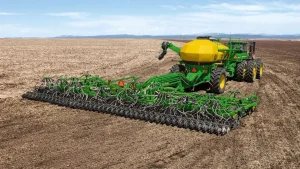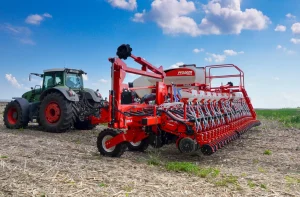Drilling grass seed is a method of planting that involves placing seeds directly into the soil at specific depths and spacing, using a specialized machine called a seed drill.
This method offers several advantages over traditional hand-sowing, including:
Improved Germination: By placing seeds at the optimal depth and ensuring good soil contact, drilling promotes uniform germination and reduces seed loss to birds or wind.
Precise Spacing: Seed drills ensure consistent spacing between seeds, which allows for more efficient use of resources and optimal plant growth.
Reduced Waste: Drilling uses less seed than hand-sowing, as there’s less chance of scattering or losing seeds.
Faster Establishment: Faster and more uniform germination often leads to quicker lawn establishment compared to hand-sowing.
Less Backbreaking Labor: Using a seed drill eliminates the need for manual broadcasting of seeds, making it a much easier and less time-consuming process.
However, drilling also has some drawbacks:
Cost: Seed drills can be expensive, especially compared to hand-sowing.
Soil Preparation: Drilling requires well-prepared soil with a fine, level surface for optimal results.
Seed Types: Not all grass seed types are suitable for drilling, especially larger seeds like ryegrass.
Initial Learning Curve: Operating a seed drill might require some practice to achieve the desired seeding rate and distribution.
Here are some things to consider when deciding whether to drill your grass seed:
- Size of your lawn: Drilling is more efficient for larger lawns, where the time and labor savings are significant.
- Soil condition: Ensure your soil is well-prepared and leveled for effective drilling.
- Seed type: Check if your chosen grass seed is suitable for drilling.
- Budget: Compare the cost of buying or renting a drill to the time and labor saved compared to hand-sowing.
If you decide to drill your grass seed, here are some steps to follow:
- Prepare your soil: Remove weeds and debris, loosen the top 2-3 inches of soil, and level the surface.
- Choose the right seed depth: Different grass seed types have different optimal planting depths. Check the instructions on your seed packet.
- Set the seed drill: Adjust the drill settings to match the desired seeding rate and depth for your chosen grass seed.
- Calibrate the drill: Run the drill on a test area to ensure you’re achieving the desired seeding rate before sowing your entire lawn.
- Sow the seed: Walk or ride the drill evenly across your lawn, ensuring good seed coverage.
- Cover the seed: Lightly rake the soil to lightly cover the seeds and prevent them from drying out.
- Water regularly: Keep the soil moist until the grass seedlings emerge.
By following these steps and carefully considering your options, you can decide whether drilling is the right method for planting your grass seed and achieving a lush, healthy lawn
Conclusion: Sowing the Seeds of Success with Drilling
Drilling grass seed, while not without its drawbacks, presents a compelling alternative to traditional hand-sowing. From improved germination and precise spacing to reduced waste and backbreaking labor, the benefits are undeniable. However, careful consideration of your budget, soil condition, seed type, and lawn size is crucial before venturing into the world of drills.
Whether you choose to meticulously sow by hand or entrust the task to a mechanical marvel, remember that both methods require time, dedication, and proper care. With diligence and a touch of green-thumb magic, any lawn can achieve lush glory – a testament to your effort, patience, and maybe even a little help from a well-calibrated drill.
FAQs: Drilling Your Way to a Greener Future
Q: My lawn is tiny. Is drilling even worth it?
A: For very small lawns, hand-sowing might be more practical. However, even for moderate-sized lawns, drilling can save time and ensure better seed distribution.
Q: What if my soil isn’t perfectly level?
A: Aim for the best you can, but don’t fret over minor imperfections. Drilling offers greater flexibility than hand-sowing and can still achieve great results on slightly uneven terrain.
Q: Can I drill any type of grass seed?
A: Most common grass seed types like fescue and bluegrass are suitable for drilling. However, larger seeds like ryegrass might be problematic. Check the seed packet instructions for specific recommendations.
Q: Where can I rent a seed drill?
A: Many hardware stores, garden centers, and equipment rental companies offer seed drills for rental. Contact your local providers for options and pricing.




